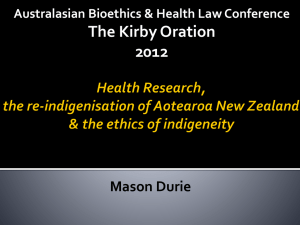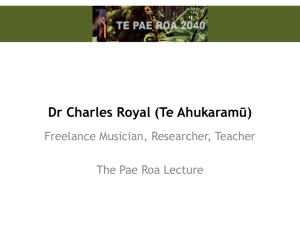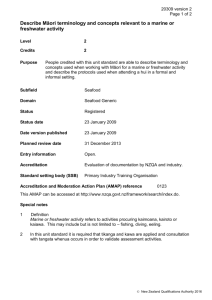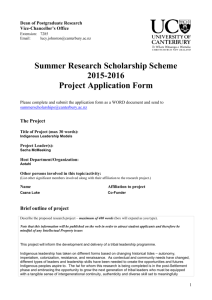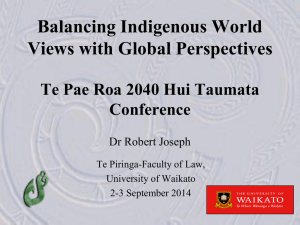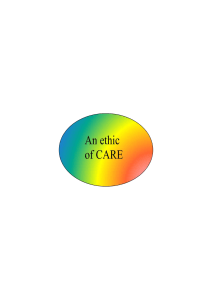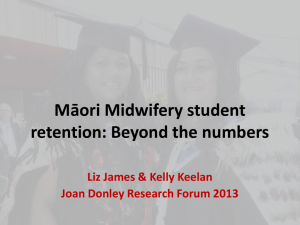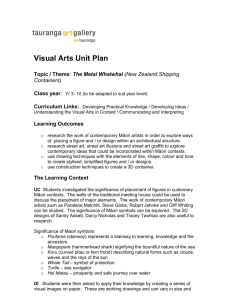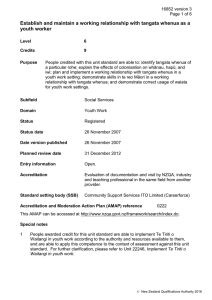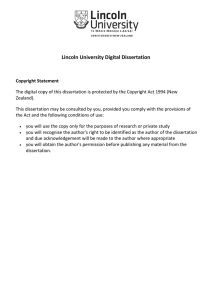Maori experiences of historical trauma and Transformative pedagogies
advertisement
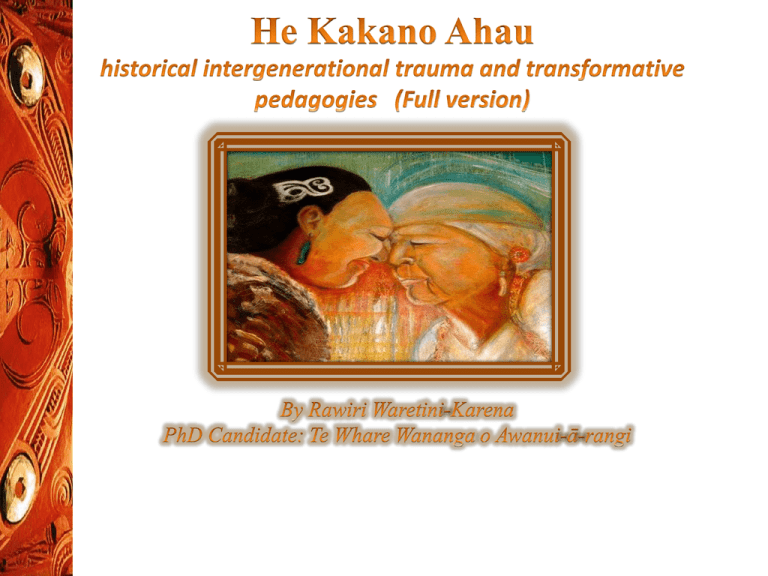
• Te Atawhai o Te Ao • Tainui waka • Ngatokimatawhaorua waka “Defined as a series of events perpetrated on a group of people and their environment with intent to systematically eradicate them " (Walters, K, 2012). Sovereignty Governor Customary Native title Rights of British people Tangata Whenua Worldview Shared Space Tangata Tiriti Worldview Te Tiriti O Waitangi 1840 –foundation: He Whakaputanga 1835 Trade & technology Lands designated for Maori Land & resources Customs, beliefs, culture Treaty of Waitangi violations Legislative - Critical Analysis Breaching TOW – To confiscate Land & resources Consequences of Breaching TOW for Tangata Whenua Native lands Act 1862 designed to break down communal ownership. Native reserves Act 1864: All remaining reserve land put under settler control of the Crown. Legislation used to acquire land and resources Breaching TOW - By Blocking all forms of redress & accountability for fraudulent actions Consequences of Breaching TOW for Tangata Whenua – Suppression of Rebellion Act 1863 • No right to trial before imprisonment. Its intention was to punish certain tribes for perceptions of rebelling against the Crown. • Legislation used to block all avenues of redress or compensation by arresting any Māori who protested. Breaching TOW – Using legislation to Assimilate & subjugate Māori culture / language & identity. Consequences of Breaching TOW for Tangata Whenua The Native Schools Act: 1867 • Schools would assist in the process of assimilation. 1871 • A Government stipulation that instruction in Native Schools had to be in • Tohunga Suppression Act: 1908 • Penalties were imposed on tohunga (experts in Maori medicine and Maori spirituality). • Legislation used to assimilate language, culture & identity • Stole land & resources • Removed traditional teachings, tikanga & protocols • Subjecting Tangata Whenua to becoming paupers on their land in direct violation of Te Tiriti 1840 • Loss of traditional principles, values & protocols • Near extinction of Māori language • Marginalization of cultural knowledge & cultural identity • Formed in 1837 in London England • Its role, to figure out how to civilise (assimilate) and Christianize Indigenous cultures • It distributed assimilating policies to settler governments in Australia, Canada and New Zealand • They decided the best way to indoctrinate the next generation was by assimilating the children... (Armitage, 1995, p.1). Personal context Institutional context Societal context Historical context. Front middle three: NZ Prime Minister Richard Sedden, Māori King Mahuta, Te Nahu Te Kuri Waretini Wetini 1892 Contextual historical intergenerational trauma in genealogy Generation 4 1840 - 1940 Te Nahu Te Kuri Waretini- Weteni. Relationship with the Colonials Generation 3 1920’s-1989 Grand Father: Kapa (Tom) Te Wharua Waretini Weteni Aftermath of colonial assimilation Generation 2 1946 – 1996 Once were Warriors generation Generation 1 Rediscovering cultural heritage Legislative Violations: Great Grandfather: Fought in the Waikato invasion against the British empire1863 Exiled with King Tawhiao into the King country. Fought along side Rewi Maniapoto and Tuhoe at Orakau Pa Brought up by Princess Te Puea Helped build Turangawaewae Marae Spoke Maori but was caned and punished in school. Fought in World War Two Moved away from Māori culture for western religion Welder-Boilermaker Mokopuna: Rawiri-David-WaretiniJunior :Karena Musician - Lecturer: Legislative violations: Native Schools Act 1867 Tohunga Suppression Act 1908 Native Health Act 1909 WW2 Hunn Report 1961 Legislative Violations: Father: Raymond Bartholomew Waretini Karena Native Lands Act Suppression of Rebellion Act 1863 Waikato Invasion Native Schools act Tohunga suppression Act Under valued anything Maori Didn’t learn tikanga Put his friends before his family Beat and abused his wife and children Was not taught any principles so did not instill values or ethics into his children Grew up with no identity Did not know my native language or culture. Brought up by the state from five years old Decided to change the cycle Chased an education Went to rediscover my cultural heritage Hunn Report 1961 Pepper potting system Rural to Urban migration Legislative Violations: Pu Ao Te Atatu NZ Constitution Act 1986 Fore shore & Seabed 2004 Takutai Moana Bill 2010 Oil drilling Fracking TPPA Key Death Great Grand Father Great Grand Mother Grand Father Grand Mother Violence Prison Father Mother Alcohol Elder sister Elder brother War Younger brother • The native idea of historical trauma involves the understanding that the trauma occurred in the spirit or soul… ( Duran, E, 2006, p.7). Rawiri & Dr Eduardo Duran 2012 • “Epigenetic research has discovered that at a cellular level, stress from one generation can be carried to the next generation (Walters, K, 2012). Rawiri & Dr Karina Walters Dr Bruce Lipton: Epigenetic Researcher • If genes respond to the environment what indicators does that have for Indigenous peoples who have been subjected to various forms of violence over generations? Historical Intergenerational Trauma Stress Substance abuse Coping Socio-cultural influences SocioEnvironmental Influences CULTURAL BUFFERS Cultural identity Ethnic pride Family-Whanau systems Alcohol & or Dug abuse Socio-Economic Influences By Walters, K & Simoni, 2002) • Violence is a spiritually conscious being, a manifested entity/energy • Oppressors who fire their energy of violence at victims perpetuate a spiritual imprint on a victims consciousness (Duran, E, 2012). Tuakiri o te Tangata Hauora Oranga Outcomes Te Whare Tapa Wha Pūrakau Model Poutama: Framework Āria: Theory Rauemi: Process Tukanga: Structure Pōwhiri Poutama Māori Ethics Ethical Practice Tikanga Ethical Value Kaupapa Māori worldview Guiding Principles Te Whiuwhiu o te Hau Māori counselling session Preferred story & strategies for wellness Support Networks Protection & safety plan Whakaoranga Whakatangitangi/ Whakaratarata Whakapuaki Whakatau He kākano āhau I ruia mai i Rangiātea1 And I can never be lost I am a seed, born of greatness Descended from a line of chiefs, He kākano āhau (Karena, R,D,W, 2012) Whakaotinga Whakaoranga Whakaratarata Whakatangitangi Whakapuaki Mihi Whakatau Whakamoemiti Effective closure To implement action plan To develop action plan & strategies To shed tears/ to bring fourth maemae Establish issues Establish Relations Spiritual/Mental Preparations By Paraire Huata Age Period Stage Characteristic 0 – 15yrs Tiaki (Cared for) The story of development begins with the stories of others, who ‘author’ the ‘preface’ and ‘introduction’ of a person’s life. 15 -25yrs Taraia (Experimentation) The life story experiments with various ‘plots’. It depends less and less ‘editing’ by others for provision. 25 – 50yrs Tino Rangatiratanga (Self-determination) The story of development takes on its own life where choices are made about with whom one becomes a ‘co-author’. Decisions are made about the ‘storyline’ of the following ‘chapters’. 50 – 65yrs Arotakenga (Evaluation) 65 – death Whanau Whanui (Extended family) The story writes into its history new ‘editions’ depending to whom the story is being told. It also is a time of reflection and evaluation Moments in one’s life story are highlighted in a ‘biography’, like a ‘movie’ being played in one’s mind. Enjoying and depending on family becomes significant Elkington, J.(2001) 0 15 15 Tiaki 25 25 Taraia 50 50 Tino Rangatira tanga Pūrakau Model: = Spaces of time in ones life = The fractured Wairua 65 65 Till death Arotakenga Whanau whanui = From tapu- or sacred To noa- or desecration Mediator Facilitator Three modes of establishing relations Deficit position Perpetrator Conscious awareness LORE Victim Teacher Cultural context Kawa Tikanga Learner • Due to ‘intent,’ spiritual violence has been delivered upon another leaving a spiritual imprint creating a turbulently poisonous reaction manifesting both internal and external consequences (Duran, 2012) Wairua Hollow Misery Spirit Hinengaro Thoughts Apprehension Broken spirit Insignificant Despair Fracture Shame Unloved Fear of being touched Non-trusting Tinana Physical Can’t communicate with others Humiliation Whanau Environment • Those who have been imprinted by the spirit of violence tend to show internal indicators such as depression, isolation, low self esteem, suicidal, or external indicators such as; • acting out in aggression, or perpetuating violence upon others (Duran, 2012). Coloured perceptions due to trauma • Spiritual problems need spiritual solutions (Duran, 2012). Iho Matua In what way do you connect to others? Mana Mauri How would you describe your worth as a person? What is your understanding of your own life essence? Waihanga Wehi What talents/coping strategies have you fostered to deal with the issue? How would you describe yourself when compared to your peers? Tapu Ihi What does the word sacred mean to you? Tell me a little about your personality? Noa Hinengaro What is it that you do to fit in with society? How do you cope in terms of processing information when feeling overwhelmed? Ngakau Pumanawa Emotionally, how has this experience impacted? What traits, skills have you genetically inherited that have enabled you to respond to the issue? Whatumanawa What is it that you hold most dear to you? Gaining an awareness 0f historical contexts Implement Indigenous strategies that respond to future wellbeing Implement Indigenous parameters that protect future generations Encourage Indigenous development for the next generation Set parameters - + Whakamana = Having limited knowledge 1 Becoming more proactive with indigenous issues 2 5 Gaining knowledge 6 Transforming self, family, community 3 4 Reclaiming indigenous position Impact of learning about Ancestors • Incorporate Māori traditional healing approaches into counselling interventions • Implement an intergenerational transfer based on a positive position at hapu and iwi level • Take charge of our historical, present and future wellbeing. • Link into international Indigenous networks to become transformative across the global Indigenous world. Armitage, A, (1995). Comparing the policy of aboriginal assimilation in Australia, Canada and New Zealand. University of, Vancouver: Canada. UBC Press. ISBN: 0-7748-0458-0 Duran, E. (2006). Healing the soul wound: Counseling with American Indians and other Native Peoples. New York, NY: Teachers College Press. Stewart, B. (Producer). (2009). Kymatica. [DVD].Retrieved March, 28, 2012 from: http://www.youtube.com/watch?v=AanQ2mY2jjc&feature=player _embedded Treaty Educations for migrant groups. (2006). Tangata Tiriti- Treaty People: An interactive workbook on the Treaty of Waitangi. Auckland: New Zealand. Auckland Workers Educational Association. Walters, K. (2012). Embodiment of historical trauma and micro-aggression distress.[Motion picture]. Retrieved March 28 2012 from: http://www.youtube.com/watch?v=WzPNWTD56S8
